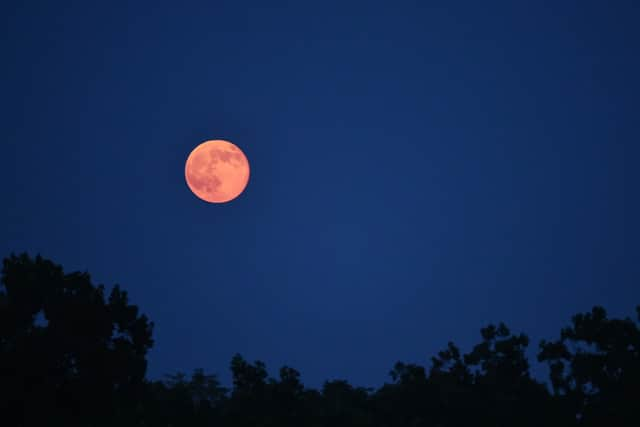Buck Moon 2022: when can I see July’s full moon in UK and what is a supermoon - date, time, spiritual meaning
and live on Freeview channel 276
Stargazers across the UK will be able to catch a glimpse of a bigger and brighter supermoon on Wednesday evening.
This month’s full moon, known as the Buck Moon, will be visible during the night of 13 July and will represent the moon arriving at its closest point to the Earth for 2022.
Advertisement
Hide AdAdvertisement
Hide AdAnna Ross, a planetarium astronomer at Royal Museums Greenwich, in south-east London said a supermoon occurs because the moon orbits the Earth on an elliptical path, rather than a circular one.


When is the best time to view the supermoon?
On Wednesday 13th July Ms Ross said the best time to view this supermoon will be any time during the night “when the moon will rise in the east just after sunset, and set in the west a little before sunrise.”
She said: “There is no particular location you need to be to observe this event as this is a bright full moon.
“As long as the night is clear of clouds it will be easy to spot whether you are in a light-polluted city or a dark area of countryside.”
Advertisement
Hide AdAdvertisement
Hide AdMs Ross added the Buck Moon will be the biggest and brightest supermoon of the year as it represents the moon arriving at its closest point to the Earth for 2022.
She explained: “As a supermoon means that the moon is a little closer to us, it will appear slightly bigger in the sky.
“The apparent difference between the size of the full moon at its closest and farthest points is only around 14% and, although if you were on the moon its brightness wouldn’t change, being that bit closer, it also overall appears to be around 30% brighter to us here on Earth.
“The average distance of the moon from the Earth is 384,400km, but the Moon will reach its closest point this lunar month on the 13th July at 09:08, when it will be 357,264 km away.
Advertisement
Hide AdAdvertisement
Hide Ad“The exact moment of the full moon closest to this point is also on the 13th July, but at 19:37. This supermoon can be referred to as a Super Buck Moon.”
She says there is no formal limit to how close the full moon needs to be to the Earth to count as a supermoon.
The Royal Astronomical Society’s deputy executive director Dr Robert Massey said “there is a lot of these” supermoons, but added: “The moon is a beautiful object – it is a fantastic thing, go out and look at it and enjoy the view.”
On Wednesday, the moonrise time from London is 9.48pm, it is 10.35pm in Edinburgh and 9.24pm in Plymouth.
Advertisement
Hide AdAdvertisement
Hide AdHe added: “So that’s when you should start looking but to see it then of course you need a perfect horizon, so you need to be looking out over a very flat landscape or the sea.”
Why is it called the Buck Moon?
July’s full moon is known as the Buck Moon because male deer shed and regrow their antlers around this time of year.
According to Ms Ross, the name came from a Native American system which uses the different months’ full moons as a calendar to keep track of the seasons.
Comment Guidelines
National World encourages reader discussion on our stories. User feedback, insights and back-and-forth exchanges add a rich layer of context to reporting. Please review our Community Guidelines before commenting.
